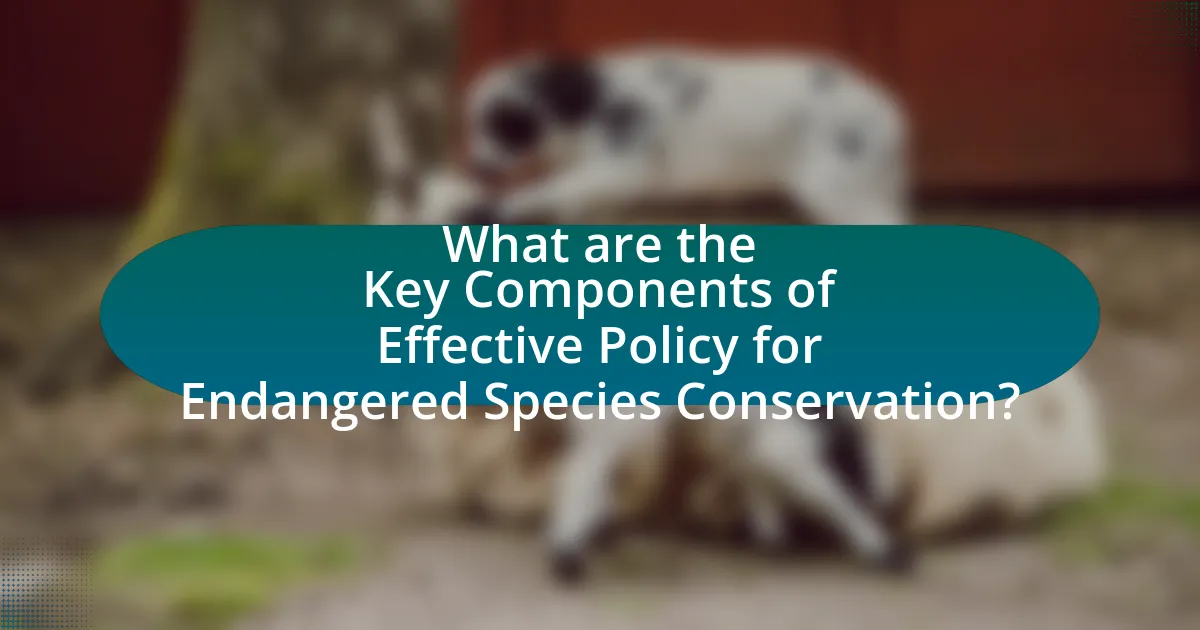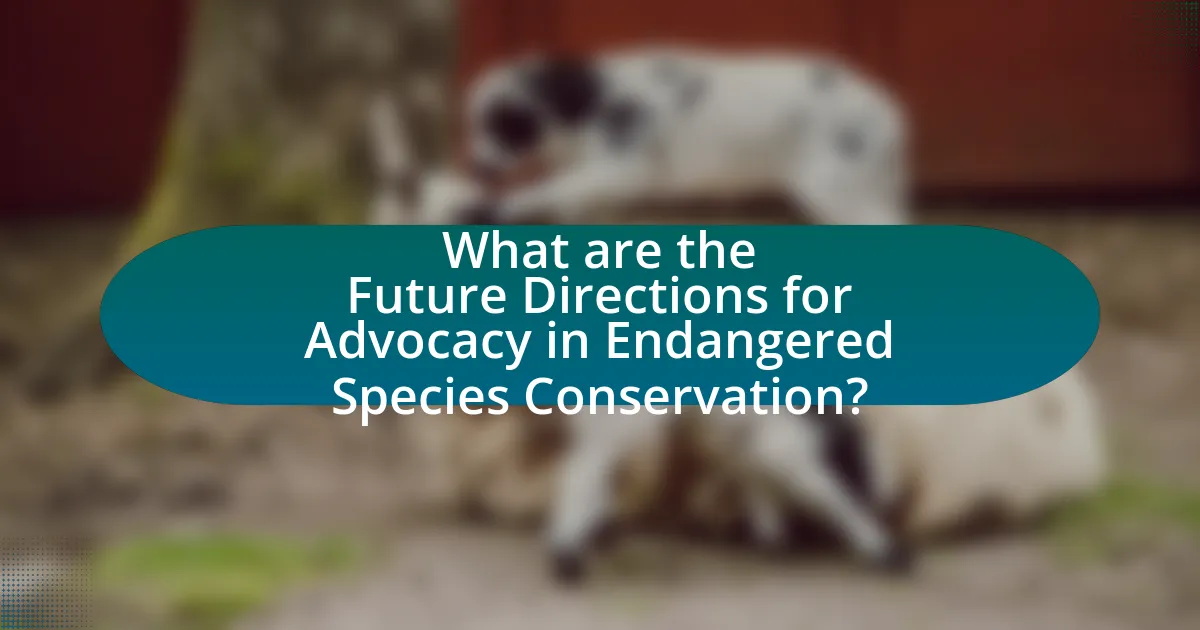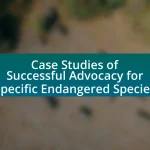The article focuses on future trends in policy and advocacy for endangered species conservation, highlighting the integration of technology, collaboration among stakeholders, and the impact of climate change on biodiversity. It examines how current policies, such as the Endangered Species Act and international agreements like CITES, shape conservation efforts and emphasizes the importance of advocacy in raising awareness and influencing policy changes. The article also discusses the role of grassroots movements, economic factors, and the significance of stakeholder engagement in developing effective conservation strategies. Additionally, it outlines innovative approaches and best practices for enhancing advocacy efforts through education, community involvement, and digital campaigns.

What are the Future Trends in Policy and Advocacy for Endangered Species Conservation?
Future trends in policy and advocacy for endangered species conservation include increased integration of technology, enhanced collaboration among stakeholders, and a focus on climate change impacts. The use of data analytics and artificial intelligence is expected to improve monitoring and enforcement of conservation laws, as evidenced by initiatives like the Wildlife Conservation Society’s use of drones for anti-poaching efforts. Collaborative frameworks, such as the Convention on Biological Diversity, are likely to strengthen partnerships between governments, NGOs, and local communities, promoting shared responsibility in conservation efforts. Additionally, policies will increasingly address the intersection of climate change and biodiversity, as highlighted by the Intergovernmental Science-Policy Platform on Biodiversity and Ecosystem Services, which emphasizes the need for adaptive management strategies that consider changing environmental conditions.
How are current policies shaping the future of endangered species conservation?
Current policies are shaping the future of endangered species conservation by establishing legal frameworks that prioritize habitat protection and species recovery. For instance, the Endangered Species Act in the United States mandates federal agencies to ensure that actions do not jeopardize the existence of listed species, thereby promoting biodiversity preservation. Additionally, international agreements like the Convention on International Trade in Endangered Species (CITES) regulate trade to prevent over-exploitation, which directly impacts species survival rates. These policies create a structured approach to conservation, enabling targeted funding and resource allocation, which is essential for effective management and recovery efforts.
What role do international agreements play in these policies?
International agreements play a crucial role in shaping policies for endangered species conservation by establishing legally binding commitments among nations to protect biodiversity. These agreements, such as the Convention on Biological Diversity and the Convention on International Trade in Endangered Species of Wild Fauna and Flora, provide frameworks for cooperation, resource sharing, and the implementation of conservation strategies. For instance, the Convention on Biological Diversity, adopted in 1992, has been ratified by 196 countries, emphasizing the global consensus on the need for collaborative efforts to conserve species and their habitats. This collective action is essential for addressing transboundary conservation challenges and ensuring that conservation policies are aligned with international standards and best practices.
How do national policies differ in their approach to conservation?
National policies differ in their approach to conservation primarily through varying regulatory frameworks, funding mechanisms, and stakeholder engagement strategies. For instance, countries like Costa Rica emphasize ecotourism and community involvement, integrating local populations into conservation efforts, while nations such as the United States utilize a more top-down regulatory approach, focusing on federal laws like the Endangered Species Act to protect specific species. Additionally, funding for conservation varies significantly; some countries allocate substantial resources to protected areas, while others rely on international aid or private sector partnerships. These differences reflect diverse ecological, economic, and cultural contexts, influencing the effectiveness of conservation strategies globally.
Why is advocacy important for endangered species conservation?
Advocacy is crucial for endangered species conservation because it raises awareness, influences policy, and mobilizes resources to protect vulnerable species. Effective advocacy campaigns can lead to legislative changes, such as the Endangered Species Act in the United States, which has successfully protected numerous species from extinction. Additionally, advocacy efforts can engage the public and stakeholders, fostering a collective responsibility towards conservation, as evidenced by initiatives like the World Wildlife Fund’s campaigns that have resulted in increased funding and support for conservation projects globally.
What strategies are effective in raising awareness for endangered species?
Effective strategies for raising awareness for endangered species include educational campaigns, social media engagement, and community involvement. Educational campaigns, such as workshops and school programs, inform the public about the importance of biodiversity and the threats faced by endangered species. Social media engagement leverages platforms like Instagram and Twitter to share compelling visuals and stories that resonate with a broader audience, increasing visibility and support. Community involvement, through local conservation projects and citizen science initiatives, fosters a sense of ownership and responsibility towards protecting endangered species. These strategies have been shown to enhance public understanding and mobilize action, as evidenced by successful campaigns like the World Wildlife Fund’s Earth Hour, which raised awareness for various species and conservation efforts globally.
How can grassroots movements influence policy changes?
Grassroots movements can influence policy changes by mobilizing community support, raising awareness, and advocating for specific legislative actions. These movements often engage local populations, creating a collective voice that can pressure policymakers to address issues, such as endangered species conservation. For instance, the grassroots campaign “Save the Manatee” successfully led to the Manatee Protection Act in Florida, demonstrating how organized community efforts can result in significant legislative outcomes. Additionally, research indicates that grassroots activism can increase public engagement and shift political priorities, as seen in the rise of environmental movements that have shaped policies on climate change and habitat protection.
What challenges do policymakers face in endangered species conservation?
Policymakers face significant challenges in endangered species conservation, primarily due to conflicting economic interests and limited funding. Economic development often takes precedence over conservation efforts, leading to habitat destruction and resource exploitation. For instance, industries such as agriculture, logging, and mining can threaten the habitats of endangered species, making it difficult for policymakers to balance economic growth with ecological preservation. Additionally, funding for conservation programs is often inadequate; a report from the World Wildlife Fund indicates that only a fraction of the necessary financial resources is allocated to protect endangered species, hindering effective policy implementation. These challenges complicate the creation and enforcement of regulations aimed at preserving biodiversity.
How do economic factors impact conservation efforts?
Economic factors significantly impact conservation efforts by influencing funding availability, resource allocation, and policy priorities. For instance, limited financial resources can lead to reduced investment in conservation programs, resulting in inadequate protection for endangered species. According to a study published in “Conservation Biology,” a lack of economic incentives often hinders local communities from participating in conservation initiatives, as they may prioritize immediate economic needs over long-term ecological benefits. Furthermore, economic growth can lead to habitat destruction through urbanization and industrial development, further threatening biodiversity. Thus, the interplay between economic conditions and conservation strategies is crucial for effective wildlife protection and habitat preservation.
What role does public opinion play in shaping conservation policies?
Public opinion significantly influences the development and implementation of conservation policies. When the public expresses strong support for environmental issues, policymakers are more likely to prioritize conservation initiatives, as seen in the increased funding for wildlife protection following public campaigns. For instance, the 2016 U.S. National Park Service report indicated that public advocacy led to the establishment of new protected areas, demonstrating that citizen engagement can directly affect policy outcomes.
How can technology enhance advocacy for endangered species?
Technology can enhance advocacy for endangered species by utilizing data analytics, social media, and mobile applications to raise awareness and mobilize support. Data analytics allows organizations to track population trends and habitat changes, providing concrete evidence for conservation efforts. Social media platforms enable rapid dissemination of information, engaging a broader audience and fostering community involvement. Mobile applications facilitate citizen science initiatives, allowing individuals to report sightings and contribute to data collection, which strengthens advocacy campaigns. For instance, the use of satellite imagery and drones has improved monitoring of endangered habitats, leading to more effective conservation strategies.
What innovative approaches are emerging in conservation advocacy?
Innovative approaches emerging in conservation advocacy include the use of technology, community engagement, and policy integration. Technology, such as drones and satellite imagery, enhances monitoring of wildlife and habitats, allowing for real-time data collection and analysis. Community engagement fosters local stewardship, empowering indigenous and local populations to participate in conservation efforts, which has been shown to improve outcomes (e.g., the success of community-managed marine areas). Additionally, integrating conservation policies with economic incentives, such as payments for ecosystem services, aligns environmental goals with economic development, promoting sustainable practices. These approaches are increasingly recognized as effective strategies for addressing the complexities of conservation in a rapidly changing world.

What are the Key Components of Effective Policy for Endangered Species Conservation?
Key components of effective policy for endangered species conservation include legal protection, habitat preservation, stakeholder engagement, and scientific research. Legal protection, such as the Endangered Species Act in the United States, establishes frameworks for the conservation of threatened species and their habitats. Habitat preservation ensures that ecosystems remain intact, which is crucial for the survival of endangered species. Stakeholder engagement involves collaboration with local communities, governments, and organizations to foster support and compliance with conservation efforts. Scientific research provides the necessary data to inform policy decisions, assess species status, and evaluate the effectiveness of conservation strategies. These components collectively enhance the resilience of endangered species and their habitats, contributing to long-term conservation success.
How do science and research inform conservation policies?
Science and research inform conservation policies by providing evidence-based data that guides decision-making and strategy development. For instance, ecological studies reveal species population dynamics and habitat requirements, which are critical for creating effective conservation plans. Research findings, such as those from the International Union for Conservation of Nature, demonstrate that policies grounded in scientific evidence lead to more successful outcomes in biodiversity preservation. Additionally, data from long-term monitoring programs, like the Global Biodiversity Outlook, highlight trends in species decline and habitat loss, prompting policymakers to implement targeted interventions. Thus, the integration of scientific research into policy frameworks ensures that conservation efforts are both effective and sustainable.
What types of data are crucial for effective policy-making?
Quantitative data, qualitative data, and geographic information are crucial for effective policy-making. Quantitative data provides measurable evidence, such as population statistics and economic impacts, which help policymakers assess the scale of issues and evaluate potential solutions. Qualitative data, including stakeholder opinions and case studies, offers insights into the social and cultural dimensions of policy issues, ensuring that diverse perspectives are considered. Geographic information, such as habitat maps and species distribution data, is essential for understanding spatial relationships and guiding conservation efforts. Together, these data types enable informed decision-making and effective resource allocation in policy development.
How can research findings be translated into actionable policies?
Research findings can be translated into actionable policies by ensuring that data is effectively communicated to policymakers through clear, concise reports and presentations. This process involves synthesizing complex research into key messages that highlight the implications for policy, thereby facilitating informed decision-making. For instance, the 2020 study by the National Academy of Sciences demonstrated that integrating scientific evidence into policy frameworks can enhance conservation outcomes, as seen in successful initiatives like the Endangered Species Act, which relies on scientific assessments to prioritize species for protection. By establishing collaborative networks between researchers and policymakers, the translation of findings into practice becomes more efficient, ultimately leading to more effective conservation strategies.
What role do stakeholders play in the policy-making process?
Stakeholders play a critical role in the policy-making process by influencing decisions, shaping agendas, and providing essential information. Their involvement ensures that diverse perspectives, including those of affected communities, conservationists, and industry representatives, are considered, which enhances the legitimacy and effectiveness of policies. For instance, in endangered species conservation, stakeholders such as local communities, NGOs, and government agencies collaborate to identify conservation priorities and develop strategies that balance ecological needs with economic interests. This collaborative approach is supported by research indicating that stakeholder engagement leads to more sustainable and accepted policy outcomes, as seen in successful conservation initiatives like the Endangered Species Act in the United States, which relies on input from various stakeholders to adapt and implement effective conservation measures.
How can collaboration between NGOs and governments improve outcomes?
Collaboration between NGOs and governments can significantly improve outcomes in endangered species conservation by leveraging resources, expertise, and networks. When NGOs partner with government agencies, they can enhance policy advocacy efforts, ensuring that conservation strategies are informed by scientific research and local knowledge. For instance, the collaboration between the World Wildlife Fund and various governments has led to the successful implementation of conservation programs that have increased the populations of endangered species, such as the Amur leopard, which saw a population increase due to joint conservation efforts. This partnership model allows for more effective resource allocation, increased public awareness, and stronger enforcement of conservation laws, ultimately leading to better protection of endangered species.
What are the benefits of involving local communities in conservation efforts?
Involving local communities in conservation efforts enhances the effectiveness and sustainability of these initiatives. Local communities possess invaluable knowledge about their ecosystems, which can lead to more informed decision-making and tailored conservation strategies. For instance, a study published in the journal “Conservation Biology” by Berkes (2009) highlights that community-based management often results in better resource stewardship and biodiversity outcomes compared to top-down approaches. Furthermore, engaging local populations fosters a sense of ownership and responsibility, increasing compliance with conservation measures. This is supported by evidence from the World Resources Institute, which indicates that when communities are actively involved, there is a 50% higher likelihood of successful conservation outcomes.
How can funding and resources be optimized for conservation policies?
Funding and resources for conservation policies can be optimized by implementing targeted allocation strategies that prioritize high-impact projects and leveraging public-private partnerships. Targeted allocation ensures that funds are directed towards initiatives with proven effectiveness, such as habitat restoration and species recovery programs, which have demonstrated success in various studies, including the recovery of the California condor through focused funding efforts. Public-private partnerships can enhance resource availability by combining governmental funding with private sector investment, as seen in initiatives like the Nature Conservancy’s collaboration with corporations to fund conservation projects. These strategies not only maximize the impact of available resources but also encourage innovative solutions and broader community engagement in conservation efforts.
What are the main sources of funding for endangered species initiatives?
The main sources of funding for endangered species initiatives include government grants, private donations, non-profit organizations, and international conservation funds. Government grants often come from federal and state agencies dedicated to wildlife conservation, such as the U.S. Fish and Wildlife Service, which allocates millions annually for species recovery programs. Private donations from individuals and corporations significantly contribute to funding, with organizations like the World Wildlife Fund and The Nature Conservancy actively soliciting support. Non-profit organizations also play a crucial role by mobilizing resources for specific projects and campaigns. Additionally, international conservation funds, such as those provided by the Global Environment Facility, support global efforts to protect endangered species, reflecting a collaborative approach to conservation funding.
How can financial incentives encourage conservation practices?
Financial incentives can encourage conservation practices by providing monetary rewards or subsidies to individuals and organizations that engage in environmentally friendly activities. These incentives can take the form of tax breaks, grants, or payments for ecosystem services, which directly offset the costs associated with conservation efforts. For instance, a study by the World Bank found that financial incentives significantly increased the adoption of sustainable land management practices among farmers, leading to improved biodiversity and ecosystem health. By aligning economic benefits with conservation goals, financial incentives create a compelling reason for stakeholders to prioritize and invest in conservation initiatives.

What are the Future Directions for Advocacy in Endangered Species Conservation?
Future directions for advocacy in endangered species conservation include leveraging technology for data collection and monitoring, enhancing community engagement, and promoting policy reforms that prioritize biodiversity. The integration of artificial intelligence and remote sensing technologies allows for more effective tracking of species populations and habitats, which can inform conservation strategies. Community involvement is crucial, as local stakeholders often have valuable insights and a vested interest in conservation efforts. Additionally, advocating for policies that address climate change and habitat destruction is essential, as these factors significantly impact species survival. For instance, the Convention on Biological Diversity emphasizes the need for sustainable practices to protect ecosystems, highlighting the importance of policy advocacy in conservation efforts.
How can social media be leveraged for conservation advocacy?
Social media can be leveraged for conservation advocacy by facilitating widespread awareness and engagement on environmental issues. Platforms like Facebook, Twitter, and Instagram enable organizations and individuals to share impactful stories, visuals, and data about endangered species, reaching diverse audiences quickly. For instance, campaigns such as #SaveTheTigers have mobilized millions, leading to increased donations and support for conservation efforts. Additionally, social media allows for real-time communication and mobilization during crises, such as poaching incidents, enabling rapid response and community action. Research indicates that social media campaigns can significantly enhance public participation in conservation initiatives, as evidenced by a study published in the journal “Conservation Biology,” which found that online engagement can lead to increased volunteerism and funding for conservation projects.
What are the best practices for engaging audiences online?
The best practices for engaging audiences online include creating interactive content, utilizing social media effectively, and personalizing communication. Interactive content, such as polls and quizzes, encourages participation and keeps audiences engaged. Research shows that posts with interactive elements can increase engagement rates by up to 50%. Utilizing social media platforms allows for real-time interaction and community building, which is essential for fostering a loyal audience. Personalizing communication, such as addressing individuals by name in emails or tailoring content to specific interests, enhances the connection with the audience. Studies indicate that personalized emails can lead to a 26% increase in open rates. These practices collectively enhance audience engagement and foster a deeper connection with the content.
How can digital campaigns drive policy change?
Digital campaigns can drive policy change by mobilizing public support and influencing decision-makers through targeted messaging and engagement. These campaigns utilize social media, email, and online petitions to raise awareness about specific issues, such as endangered species conservation, thereby creating a sense of urgency and community around the cause. For instance, the #SaveTheElephants campaign successfully garnered millions of signatures and media attention, leading to legislative discussions on elephant protection in various countries. This demonstrates that digital campaigns can effectively translate public sentiment into policy action by leveraging data analytics to identify key stakeholders and tailor messages that resonate with them.
What role does education play in future advocacy efforts?
Education plays a crucial role in future advocacy efforts by equipping individuals with the knowledge and skills necessary to effectively promote and protect endangered species. Through education, advocates can raise awareness about biodiversity loss, the importance of conservation, and the specific needs of endangered species, thereby fostering a more informed public. Research indicates that educational programs can significantly enhance public engagement and support for conservation initiatives, as seen in studies showing that communities with strong educational outreach have higher participation rates in conservation activities. Furthermore, education empowers future leaders in advocacy by providing them with the tools to influence policy decisions and mobilize resources for conservation efforts.
How can educational programs raise awareness about endangered species?
Educational programs can raise awareness about endangered species by providing targeted information and engaging activities that highlight the importance of biodiversity and conservation. These programs often include interactive workshops, field trips, and multimedia presentations that educate participants about the threats faced by endangered species, such as habitat loss and climate change. For instance, a study by the World Wildlife Fund found that educational initiatives that involve hands-on experiences significantly increase participants’ knowledge and concern for endangered species, leading to greater advocacy efforts. By fostering a deeper understanding of ecological interdependence, educational programs empower individuals to take action in their communities, thereby enhancing conservation efforts.
What partnerships can enhance educational outreach?
Collaborations between educational institutions, non-profit organizations, and governmental agencies can significantly enhance educational outreach. Educational institutions can provide research and expertise, while non-profits can leverage community connections and resources to disseminate information effectively. Governmental agencies can offer funding and policy support, creating a comprehensive framework for outreach initiatives. For instance, partnerships like the National Wildlife Federation’s collaboration with schools have successfully increased awareness about endangered species through curriculum development and community programs. This multi-faceted approach ensures a broader reach and more impactful educational efforts.
What practical steps can individuals take to support endangered species conservation?
Individuals can support endangered species conservation by actively participating in habitat restoration projects. Engaging in local conservation efforts, such as tree planting or wetland restoration, directly contributes to the preservation of ecosystems that endangered species rely on. According to the World Wildlife Fund, habitat loss is a primary threat to biodiversity, making restoration initiatives crucial for species survival. Additionally, individuals can advocate for policy changes by contacting local representatives to support legislation aimed at protecting endangered species, as public support has been shown to influence conservation policy decisions.


